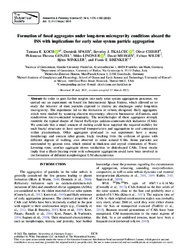Formation of fused aggregates under long‐term microgravity conditions aboard the ISS with implications for early solar system particle aggregation
Spahr, Dominik
Christ, Oliver
Genzel, Philomena‐Theresa
Merges, David
Wilde, Fabian
Winkler, Björn
DOI: https://doi.org/10.1111/maps.13815
Persistent URL: http://resolver.sub.uni-goettingen.de/purl?gldocs-11858/10270
Persistent URL: http://resolver.sub.uni-goettingen.de/purl?gldocs-11858/10270
Koch, Tamara E.; Spahr, Dominik; Tkalcec, Beverley J.; Christ, Oliver; Genzel, Philomena‐Theresa; Lindner, Miles; Merges, David; Wilde, Fabian; Winkler, Björn; Brenker, Frank E., 2022: Formation of fused aggregates under long‐term microgravity conditions aboard the ISS with implications for early solar system particle aggregation. In: Meteoritics & Planetary Science, Band 57, 6: 1174 - 1193, DOI: 10.1111/maps.13815.
 |
Dokument öffnen: |
In order to gain further insights into early solar system aggregation processes, we carried out an experiment on board the International Space Station, which allowed us to study the behavior of dust particles exposed to electric arc discharges under long‐term microgravity. The experiment led to the formation of robust, elongated, fluffy aggregates, which were studied by scanning electron microscopy, electron backscatter diffraction, and synchrotron micro‐computed tomography. The morphologies of these aggregates strongly resemble the typical shapes of fractal fluffy‐type calcium‐aluminum‐rich inclusions (CAIs). We conclude that a small amount of melting could have supplied the required stability for such fractal structures to have survived transportation and aggregation to and compaction within planetesimals. Other aggregates produced in our experiment have a massy morphology and contain relict grains, likely resulting from the collision of grains with different degrees of melting, also observed in some natural CAIs. Some particles are surrounded by igneous rims, which remind in thickness and crystal orientation of Wark–Lovering rims; another aggregate shows similarities to disk‐shaped CAIs. These results imply that a (flash‐)heating event with subsequent aggregation could have been involved in the formation of different morphological CAI characteristics.
Statistik:
ZugriffsstatistikSammlung:
This is an open access article under the terms of the Creative Commons Attribution‐NonCommercial‐NoDerivs License, which permits use and distribution in any medium, provided the original work is properly cited, the use is non‐commercial and no modifications or adaptations are made.

